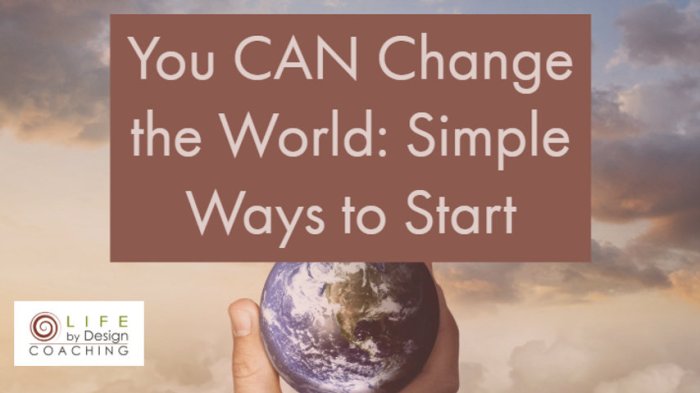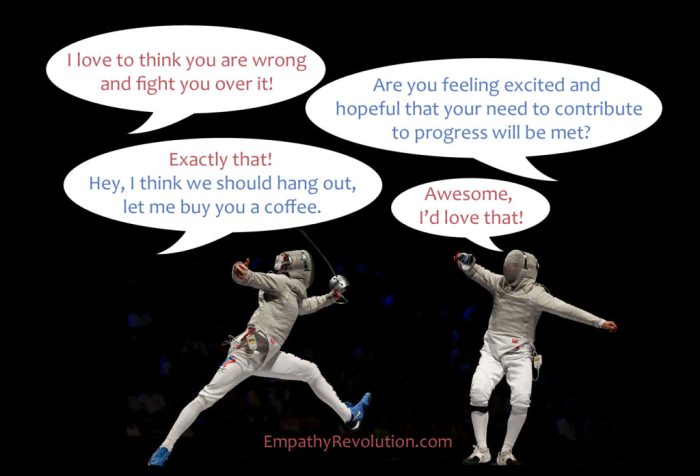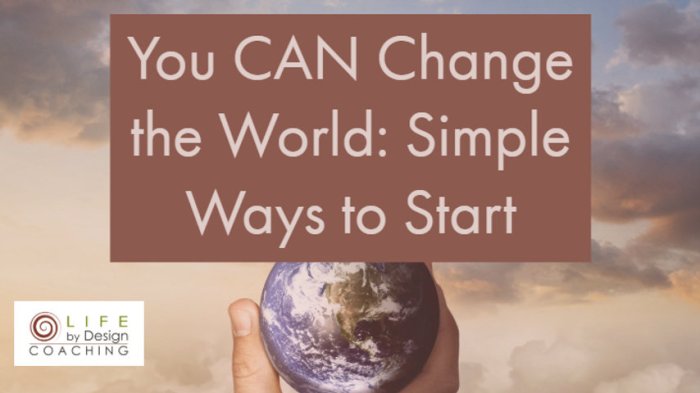
10 ways to peacefully and effectively change the world is a journey into the heart of positive global impact. This exploration delves into how individuals and communities can work together to achieve a better future, emphasizing the power of peaceful strategies over violent ones.
We’ll examine historical movements that achieved significant change peacefully, explore individual actions that create ripples of change, and analyze systemic issues that hinder progress. Learning how to communicate effectively, foster inclusivity, and cultivate a culture of peace will be key elements in this discussion. Sustainable practices and empowering marginalized groups will be integral to achieving a lasting positive impact on the world.
Understanding the Concept of Peaceful Change
Peaceful change, in the context of global impact, encompasses efforts to improve society and address pressing issues without resorting to violence or coercion. It involves a commitment to dialogue, negotiation, and collaboration to effect positive transformations. This approach recognizes the inherent dignity of all individuals and the importance of respecting diverse perspectives. Successful peaceful change often relies on sustained advocacy, building broad coalitions, and leveraging the power of collective action.This pursuit of peaceful change is not merely an idealistic aspiration, but a demonstrably effective strategy for addressing complex societal challenges.
History is replete with examples of movements that achieved profound social and political shifts through non-violent means. Understanding these historical precedents, along with the dynamics of peaceful and violent approaches, is crucial for fostering positive and sustainable change.
Defining “Peaceful Change”
Peaceful change, fundamentally, is a process of transformation that avoids the use of physical force or intimidation. It prioritizes dialogue, negotiation, and the pursuit of common ground to achieve desired outcomes. This approach recognizes that lasting solutions are often built upon mutual understanding and respect.
Examples of Peaceful Movements
Numerous historical movements demonstrate the efficacy of peaceful change. The Civil Rights Movement in the United States, led by figures like Martin Luther King Jr., employed non-violent protests and civil disobedience to dismantle discriminatory laws and practices. The anti-apartheid movement in South Africa, spearheaded by activists like Nelson Mandela, used boycotts, strikes, and other non-violent strategies to dismantle the oppressive system of apartheid.
The women’s suffrage movement, across various nations, achieved significant gains in political rights through persistent advocacy, demonstrations, and public awareness campaigns. These examples illustrate the power of collective action and the potential for positive social change through peaceful means.
Comparing Peaceful and Violent Approaches
Peaceful approaches to social change typically aim to foster dialogue and understanding. They prioritize collaboration and seek common ground. Violent approaches, conversely, often escalate conflict and create lasting divisions. While violence may sometimes achieve short-term gains, it rarely leads to sustainable or just solutions. The long-term consequences of violence frequently include widespread suffering, social fragmentation, and an environment of fear and mistrust.
The difference lies in the means employed to achieve the desired outcomes.
Empathy and Understanding in Peaceful Change
Empathy plays a critical role in fostering peaceful change. By actively seeking to understand the perspectives and experiences of others, individuals and groups can build bridges of communication and cooperation. This understanding helps to identify common ground, address grievances, and create a foundation for mutually beneficial outcomes. Empathy facilitates the creation of a space where diverse voices can be heard and respected, leading to more inclusive and equitable solutions.
Framework for Identifying and Resolving Conflicts Peacefully
A framework for identifying potential conflicts and finding peaceful resolutions involves several key steps. First, recognizing the underlying causes of conflict is paramount. Second, fostering open communication and dialogue between all involved parties is essential. Third, identifying common interests and shared values is crucial for building bridges. Fourth, developing creative and mutually acceptable solutions is paramount.
Finally, establishing mechanisms for monitoring and evaluating the effectiveness of the resolution is critical for ensuring long-term success. This process requires a commitment to active listening, respect, and a willingness to compromise.
Individual Actions for Positive Change
Transforming the world, even in a small way, begins with individual actions. We often underestimate the power of our choices and the ripple effect they can have on the communities around us. Small, consistent acts of kindness and positive change, when multiplied across numerous individuals, create a powerful force for good. This section delves into practical steps individuals can take to promote a more peaceful and just world.Individual actions, when consistently applied, can create a positive and significant impact on a larger scale.
This impact isn’t limited to direct interactions but extends to influencing social norms and fostering a culture of compassion and responsibility. The ripple effect of individual actions is powerful and far-reaching, creating a domino effect of positive change.
Ten Actions for Positive Change
Consistent positive actions, even seemingly small ones, have a profound impact. These actions, when combined, contribute to a larger movement towards a better world.
- Support Ethical Businesses: Choosing to buy from businesses that prioritize ethical labor practices, environmental sustainability, and fair trade creates a demand for these practices. By supporting these businesses, you are directly contributing to positive change in the supply chain and promoting more sustainable business models. For example, a conscious consumer might opt for clothing made from recycled materials or sourced through fair trade cooperatives, supporting companies that prioritize sustainability and worker rights.
- Advocate for Policy Changes: Contacting elected officials, participating in peaceful protests, and signing petitions are all ways to advocate for policies that promote positive change. These actions demonstrate the collective will for change, which can significantly impact the policies and laws that govern our society. For example, writing letters to representatives, attending town hall meetings, or joining organizations working on specific issues like climate change can be effective advocacy tools.
- Volunteer Your Time: Volunteering time to help others or support causes you care about is a powerful way to contribute to positive change in your community. Whether it’s helping at a local food bank, mentoring youth, or participating in environmental cleanup initiatives, volunteering demonstrates compassion and strengthens community bonds. This can improve social cohesion and build a sense of shared responsibility.
- Educate Yourself and Others: Learning about social issues and sharing that knowledge with others is a critical step in fostering understanding and promoting empathy. This includes learning about different cultures, perspectives, and social issues, and sharing that knowledge with friends, family, and colleagues.
- Practice Active Listening: Active listening is crucial in fostering understanding and empathy. When we listen attentively to others, we show respect and create a space for open dialogue, which can lead to more peaceful conflict resolution and more productive communication.
- Promote Inclusivity and Diversity: Actively working to create more inclusive and diverse communities can promote respect and understanding. This involves challenging stereotypes, supporting marginalized groups, and celebrating diversity.
- Practice Forgiveness: Forgiveness, both for oneself and others, is crucial for personal growth and promoting a more compassionate society. Holding onto resentment and anger can hinder personal well-being and create obstacles in peaceful interactions.
- Reduce Your Environmental Footprint: Conserving resources, reducing waste, and adopting sustainable practices can have a significant impact on the environment. Small changes, such as recycling, reducing energy consumption, and using reusable items, can collectively contribute to a more sustainable future.
- Promote Peaceful Conflict Resolution: Conflict is inevitable, but it doesn’t have to be destructive. Learning and practicing peaceful conflict resolution techniques, such as mediation and negotiation, can lead to more positive outcomes and create a more harmonious society.
- Support Peaceful Movements: Joining or supporting peaceful movements and organizations working towards positive social change demonstrates a commitment to collective action. This can range from joining environmental groups to advocating for human rights. Supporting these efforts, even in small ways, can have a profound impact on the larger movement.
Ripple Effect of Individual Actions
Individual actions have a far-reaching effect on communities and society as a whole. A single act of kindness, for instance, can inspire others to emulate that behavior, leading to a broader culture of compassion.
- Impact on Communities: Volunteer work at a local soup kitchen can alleviate immediate needs, foster community spirit, and inspire others to get involved. Similarly, reducing your environmental footprint can lead to cleaner air and water, impacting the health of the entire community. This shows how individual actions have immediate and long-term effects.
Motivating Others
Inspiring others to participate in peaceful change requires empathy, understanding, and a shared vision. Clearly communicating the benefits and positive impact of these actions is key to encouraging participation.
- Sharing Success Stories: Highlighting the positive outcomes of individuals and groups actively engaged in peaceful change can motivate others. This can include personal accounts, stories of community projects, or examples of successful social movements.
Personal Responsibility
Personal responsibility is fundamental to achieving global change. It acknowledges that each individual plays a vital role in shaping the world around them.
- Individual Responsibility: Recognizing and accepting individual responsibility for positive change is essential to creating a more just and peaceful world. This means understanding that our actions, both large and small, have consequences and that we have a role to play in creating a better future.
Systemic Approaches to Change
Transforming the world peacefully requires understanding and addressing systemic issues that hinder progress. This involves identifying the root causes of problems, not just their symptoms, and developing strategies for sustainable change. A crucial aspect of this approach is recognizing that individual actions, while important, often need to be complemented by broader societal shifts.Effective change necessitates understanding the intricate web of interconnected factors shaping our societies.
From economic disparities to political power imbalances, systemic issues often manifest in various forms of inequality and oppression. By analyzing these systems, we can develop targeted strategies to dismantle harmful structures and promote inclusivity and equity.
Key Systemic Issues Hindering Peaceful Change
Systemic issues often act as barriers to peaceful change, perpetuating cycles of inequality and conflict. These issues are deeply entrenched and require sustained effort to address. Some prominent examples include discriminatory policies, economic inequality, and lack of access to resources. These issues often intersect and reinforce one another, creating complex challenges.
- Discriminatory policies: Laws and regulations that disadvantage certain groups based on race, gender, religion, or other factors can perpetuate systemic inequalities. For example, discriminatory housing policies can lead to residential segregation and limited access to resources for marginalized communities.
- Economic inequality: Significant disparities in wealth and income can create a cycle of poverty and limited opportunity. This can lead to social unrest and impede progress towards a more equitable society. For example, unequal access to education and job opportunities can contribute to the widening gap between the rich and poor.
- Lack of access to resources: Limited access to essential resources such as healthcare, education, and clean water can exacerbate existing inequalities and hinder development. This can lead to poorer health outcomes and limited opportunities for social mobility.
Strategies for Addressing Systemic Issues Effectively
Effective strategies for addressing systemic issues require a multifaceted approach, incorporating various types of activism and collaborative efforts. These strategies should be tailored to the specific context and needs of the communities being served.
- Grassroots activism: Building local support and organizing community-based initiatives is crucial for creating change from the bottom up. This can involve organizing protests, community meetings, and advocating for policy changes at the local level. For instance, neighborhood associations campaigning for better public transportation or environmental protection exemplify grassroots efforts.
- Political activism: Engaging in the political process by advocating for policy changes at the national or international level is essential for systemic change. This involves lobbying, campaigning, and advocating for legislation that promotes equity and justice. For example, lobbying for stricter environmental regulations or raising awareness about human rights violations through political campaigns can be effective strategies.
- Social activism: Raising awareness about social issues through education, outreach, and advocacy can create public pressure for change. Social movements, such as the civil rights movement or the women’s suffrage movement, demonstrate the power of social activism in achieving systemic change.
Importance of Inclusivity and Diversity in Social Movements
Inclusivity and diversity are vital for effective social movements. Diverse perspectives and experiences enrich the movement, leading to more comprehensive and effective strategies. When different groups are represented, the movement is better equipped to address the needs and concerns of all members of society.
- Broader representation: Social movements should actively seek participation from diverse groups, including marginalized communities. This includes women, people of color, LGBTQ+ individuals, people with disabilities, and others who have historically been excluded.
- Respectful dialogue: Open and respectful dialogue between diverse groups is crucial for understanding different perspectives and working collaboratively toward common goals.
- Shared leadership: Empowering leaders from diverse backgrounds fosters a sense of ownership and responsibility within the movement, leading to more sustainable and impactful change.
Developing and Implementing Policies for Positive Change
Developing and implementing policies for positive change is a complex process that requires careful consideration and collaboration. This process often involves multiple steps and stakeholders.
- Policy analysis: A thorough analysis of existing policies and their impact on various groups is crucial. This should consider potential unintended consequences and the impact on different communities.
- Policy development: Based on the analysis, policies can be developed to address the identified systemic issues. This process should involve input from affected communities and stakeholders.
- Policy implementation: Policies need to be effectively implemented to achieve their intended goals. This requires clear communication, resources, and monitoring mechanisms.
Communication and Collaboration
Building a better world often hinges on our ability to connect, understand, and work together. Effective communication and collaboration are cornerstones of peaceful change initiatives, fostering understanding and shared action. This section delves into the crucial role these elements play in driving positive social transformations.Respectful dialogue across diverse groups is essential for progress. Disagreement is inevitable, but open and honest communication, combined with empathy and active listening, can turn disagreements into opportunities for learning and growth.
These elements are paramount for any change initiative.
The Importance of Effective Communication
Clear and concise communication is fundamental to any peaceful change initiative. Misunderstandings can derail even the best-laid plans. Effective communication creates a shared understanding of goals, fosters trust, and empowers individuals to actively participate in the process. It allows for the free flow of information, ensuring everyone is on the same page and working towards common objectives.
Examples include clear statements of goals, consistent messaging across platforms, and active feedback mechanisms.
Fostering Respectful Dialogue
Respectful dialogue across diverse groups requires a conscious effort to understand different perspectives. Active listening is key. This involves not just hearing words but also understanding the underlying emotions and experiences that shape the viewpoints of others. Emphasizing common ground and shared values is crucial. Acknowledging and validating diverse viewpoints, even if not agreeing with them, is essential.
Creating a safe space for open dialogue, free from intimidation or judgment, is critical. This includes setting clear ground rules for respectful interaction.
Building Bridges Between Communities
Bridging divides between different communities necessitates understanding and empathy. Identifying shared interests and concerns is paramount. Facilitating opportunities for people from different backgrounds to interact and collaborate can foster a sense of community and belonging. This could involve joint projects, community events, or mentorship programs. Creating a shared narrative is vital.
This could involve co-creating stories, highlighting shared history, and celebrating common cultural elements.
Empathy and Active Listening in Conflict Resolution
Empathy, the ability to understand and share the feelings of another, is crucial in conflict resolution. Active listening, paying close attention to what others are saying, both verbally and nonverbally, helps in identifying underlying concerns and fostering understanding. Empathy and active listening, when used together, can transform conflicts into opportunities for growth and reconciliation. Active listening allows individuals to understand the perspective of the other party, while empathy helps in appreciating the context surrounding their viewpoint.
Strategies for Collaboration with Stakeholders
Successful change initiatives require collaboration with diverse stakeholders. This includes government agencies, community organizations, businesses, and individuals. A well-defined stakeholder map helps identify key players and their respective roles. Understanding the needs and priorities of each stakeholder is crucial. Developing strategies to engage stakeholders effectively is essential.
This could include creating working groups, organizing meetings, and establishing clear communication channels. Identifying common goals and interests will enhance cooperation.
Education and Awareness
Igniting change often begins with a spark of awareness. Education, in its broadest sense, empowers individuals to understand the complexities of the world around them and to see the potential for positive action. By fostering critical thinking and empathy, education equips people with the tools to identify problems, evaluate solutions, and contribute meaningfully to societal progress. A well-informed populace is a powerful force for peaceful change.Education and awareness are not passive processes.
They require active engagement, thoughtful reflection, and a willingness to challenge preconceived notions. This active engagement can take many forms, from formal learning to informal discussions and personal exploration. A key component is recognizing that change often requires a shift in perspective, challenging assumptions, and acknowledging diverse viewpoints.
The Power of Education in Promoting Peaceful Change
Education is a fundamental tool for peaceful change. It equips individuals with the knowledge and critical thinking skills necessary to understand complex social issues and evaluate different approaches to solving them. Learning about diverse perspectives, historical context, and the root causes of conflict fosters empathy and understanding, which are essential for building peaceful relationships. By providing access to accurate information, education helps dismantle misinformation and prejudice, which are often obstacles to peaceful coexistence.
Thinking about 10 ways to make a positive impact on the world? It’s a big ask, but even small steps can make a difference. Connecting with nature, like exploring the woods, is incredibly important for mental clarity and creativity, as demonstrated in this insightful article about man nature how going the woods strengthens your brain power.
This connection to the natural world can actually fuel our ability to brainstorm innovative solutions and inspire new approaches to peaceful and effective change. Ultimately, focusing on our well-being and appreciating nature can help us find the strength to make a real difference in the world.
Methods for Raising Awareness about Critical Social Issues
Raising awareness about critical social issues requires a multifaceted approach. Public forums, workshops, and community events can provide platforms for dialogue and knowledge sharing. Using social media, websites, and other online platforms allows for wider dissemination of information. Creating compelling visuals, such as documentaries or infographics, can make complex issues more accessible and engaging for a wider audience.
The use of relatable stories and personal narratives can significantly increase the impact of awareness campaigns.
The Role of Storytelling and Narrative in Inspiring Change
Stories have a profound impact on shaping perceptions and motivating action. Personal narratives, historical accounts, and fictional stories can vividly illustrate the consequences of conflict and the potential for peace. Storytelling humanizes complex issues, making them relatable and emotionally engaging. This emotional connection can inspire empathy and motivate individuals to take action. Effective storytelling can create a sense of shared experience, uniting people around a common purpose.
Resources for Disseminating Information about Peaceful Change
A variety of resources can be utilized to disseminate information about peaceful change. Educational institutions, non-governmental organizations (NGOs), and community centers can host workshops, seminars, and lectures. News outlets, online platforms, and social media can be leveraged to reach a wider audience. Government agencies and international organizations often publish resources and information related to peaceful conflict resolution.
Books, articles, and documentaries provide additional avenues for educating the public.
A Detailed Plan for a Public Awareness Campaign
| Phase | Activities | Target Audience | Resources |
|---|---|---|---|
| Phase 1: Research and Planning | Identify target audience, define key messages, select appropriate channels. | Community leaders, educators, campaign staff | Surveys, focus groups, research reports, budget analysis |
| Phase 2: Content Creation | Develop educational materials (e.g., videos, infographics, presentations, social media posts). | General public | Graphic designers, videographers, writers |
| Phase 3: Dissemination | Utilize various channels (social media, community events, local news outlets) to disseminate materials. | General public, community members | Social media managers, event organizers, local media contacts |
| Phase 4: Evaluation and Feedback | Track campaign progress, collect feedback, and adjust strategies as needed. | Campaign staff, target audience | Analytics tools, surveys, feedback forms |
“Education is the most powerful weapon which you can use to change the world.”
Nelson Mandela
Sustainable Practices and Solutions: 10 Ways To Peacefully And Effectively Change The World
A world striving for peace must inevitably consider the crucial role of environmental sustainability. The interconnectedness of human actions and the health of our planet is undeniable. Ignoring the ecological crisis is not an option; rather, we must integrate sustainable practices into the very fabric of our pursuit of a better future. Sustainable solutions are not merely a “nice-to-have,” but a fundamental requirement for long-term peace and prosperity.Sustainable practices are not simply about reducing our environmental footprint; they are about creating a more just and equitable world for all.
By shifting towards renewable energy, adopting responsible consumption patterns, and prioritizing resource efficiency, we can build a foundation for a more peaceful and prosperous future. This approach not only safeguards the environment but also fosters social cohesion and economic stability.
Connection Between Environmental Sustainability and Peaceful Change
Environmental degradation often exacerbates existing social inequalities and conflicts. Scarcity of resources, like water and arable land, can lead to disputes and displacement. Sustainable practices, therefore, play a crucial role in preventing such conflicts. A healthy environment provides the essential resources needed for a thriving society, thus promoting peace.
Examples of Sustainable Practices
Transitioning to renewable energy sources, such as solar and wind power, reduces reliance on fossil fuels and minimizes greenhouse gas emissions. Adopting sustainable agricultural practices, such as permaculture and agroforestry, enhances soil health, conserves water, and promotes biodiversity. Promoting responsible consumption and reducing waste minimizes environmental impact.
Role of Resource Management in Creating Positive Change
Efficient resource management is critical for sustainable development. This includes responsible water management, efficient energy use, and responsible waste disposal. Proper waste management systems, for example, reduce pollution and provide valuable resources for recycling. By optimizing resource use, we create a more sustainable and resilient future, promoting peace by ensuring access to essential resources for all.
Comparison of Different Approaches to Sustainable Living
Various approaches to sustainable living exist, ranging from individual lifestyle changes to large-scale systemic transformations. Eco-friendly products, reduced meat consumption, and promoting public transportation are all examples of individual actions. Government policies supporting renewable energy, carbon taxes, and stricter environmental regulations are examples of systemic approaches. Each approach, when combined, creates a holistic approach to sustainable living.
Plan for Implementing Sustainable Solutions on a Global Scale
Implementing sustainable solutions globally requires a multifaceted approach involving international cooperation, technological innovation, and community engagement. Governments must establish clear policies and regulations promoting sustainable practices. International organizations can facilitate knowledge sharing and resource allocation for sustainable projects. Community engagement and education are essential to foster widespread adoption of sustainable practices.This plan emphasizes a collaborative effort involving governments, businesses, and individuals.
Promoting education about environmental issues and sustainable practices is vital. The ultimate goal is a global transition to sustainable practices that ensure a peaceful and prosperous future for all.
Addressing Inequality and Discrimination
Inequality and discrimination are significant obstacles to peaceful change. They create divisions within societies, hindering collaboration and progress. When individuals and groups feel marginalized or oppressed, their potential for contributing to a positive future is diminished. Addressing these issues is crucial for building a truly inclusive and equitable world.Addressing the roots of inequality and discrimination is not just about fairness; it’s about unlocking the full potential of every individual and community.
By dismantling discriminatory systems and promoting social justice, we create fertile ground for peaceful change to flourish. This allows for the emergence of innovative solutions, the development of strong social networks, and the flourishing of creativity and cooperation.
Impact of Inequality and Discrimination on Peaceful Change
Inequality and discrimination create a climate of distrust and fear. Marginalized groups often lack access to resources, opportunities, and power structures, which limits their ability to participate fully in societal progress. This lack of participation can lead to resentment and conflict, undermining efforts towards peaceful change. Discrimination can manifest in various forms, such as racial bias, gender inequality, or socioeconomic disparities, all of which negatively affect peaceful change initiatives.
Thinking about 10 ways to make a positive impact on the world? It’s a great goal, and it’s definitely important to address societal pressures and harmful stereotypes. For example, the whole idea of blaming women for not wanting children is frankly ridiculous. Check out this insightful article exploring 10 reasons why nonsense blame women for not wanting babies – it highlights how focusing on individual choices rather than societal support is completely unproductive.
Ultimately, achieving lasting change requires addressing the root causes, not just the symptoms, and finding constructive solutions for everyone involved. Let’s work together towards those 10 peaceful and effective changes!
Strategies for Challenging Discriminatory Practices
Challenging discriminatory practices requires a multi-faceted approach. It involves identifying and addressing systemic issues that perpetuate inequality. Crucial steps include:
- Promoting education and awareness campaigns to challenge harmful stereotypes and biases.
- Supporting organizations that advocate for the rights of marginalized groups.
- Implementing policies that promote equal opportunities and access to resources for all.
- Encouraging dialogue and interaction between different groups to foster understanding and empathy.
- Holding individuals and institutions accountable for discriminatory actions.
These strategies are essential for creating a more just and equitable society.
Thinking about 10 ways to make a positive impact on the world? It’s awesome! But did you know that feeling good about yourself and your actions can actually increase your ability to effect change? Boosting your serotonin levels naturally, through things like getting enough sunlight or practicing gratitude, can lead to a more positive outlook and help you approach the world with a sense of calm and purpose.
Check out 11 ways increase the serotonin your brain naturally for some practical tips. Ultimately, focusing on personal well-being can be a powerful tool in your arsenal for peaceful and effective global change.
Examples of Successful Campaigns to Combat Inequality
Numerous successful campaigns have demonstrated the power of collective action in combating inequality. The Civil Rights Movement in the United States, for example, successfully challenged racial segregation and discrimination. Similarly, campaigns advocating for women’s rights have achieved significant progress in areas like equal pay and reproductive rights. These examples demonstrate the potential for positive change when people come together to challenge injustice.
The impact of these movements is evident in the progress made towards greater equality and social justice.
Importance of Social Justice in Promoting Peaceful Change
Social justice is fundamental to peaceful change. It ensures that all individuals and groups have equal opportunities and rights. By addressing historical and systemic injustices, we can create a more equitable society where everyone can contribute their talents and skills to build a better future. Social justice is crucial for fostering a sense of belonging and promoting unity among diverse groups.
It enables a more just and equitable society, where people from all walks of life can thrive.
Creating an Inclusive Society
Creating an inclusive society involves actively working to dismantle barriers that prevent marginalized groups from participating fully in society. This includes:
- Promoting diversity and inclusion in workplaces, educational institutions, and communities.
- Creating policies and practices that ensure equitable access to resources and opportunities.
- Challenging discriminatory attitudes and behaviors through education and awareness campaigns.
- Supporting organizations that advocate for the rights of marginalized groups.
- Promoting a culture of respect and understanding in society.
These measures foster a sense of belonging and create a supportive environment for everyone. This fosters collaboration and mutual respect, essential ingredients for peaceful change.
Empowering Marginalized Groups
Empowering marginalized groups is crucial for creating a more just and equitable world. Marginalization, stemming from factors like race, ethnicity, gender, socioeconomic status, religion, or disability, often leads to systemic disadvantages, hindering access to opportunities and resources. Addressing these disparities requires a multifaceted approach that recognizes the unique challenges faced by each group and empowers them to become agents of change within their communities.
Identifying Marginalized Groups
Marginalized groups encompass a wide range of individuals and communities facing systemic disadvantages. These groups often experience discrimination, prejudice, and limited access to essential resources, including education, employment, healthcare, and housing. Examples include racial and ethnic minorities, women, LGBTQ+ individuals, people with disabilities, and those living in poverty. Recognizing the diverse dimensions of marginalization is essential for developing targeted interventions.
Methods for Empowerment
Empowering marginalized groups necessitates a multi-pronged strategy. These methods include providing access to quality education and vocational training, fostering economic opportunities through entrepreneurship programs and job creation initiatives, promoting political participation through voter registration drives and leadership development programs, and ensuring access to healthcare and social services. Supporting the development of community-based organizations and initiatives that address specific needs within the community is also vital.
A critical component is ensuring representation and leadership within institutions and decision-making processes, allowing marginalized voices to shape policies and programs that directly impact their lives.
Recognizing Diverse Perspectives in Social Movements, 10 ways to peacefully and effectively change the world
Social movements for change are strengthened by diverse perspectives. Understanding and valuing the unique experiences and insights of all marginalized groups is essential for creating a collective movement that is inclusive and effective. Recognizing the intersections of various forms of marginalization, such as the interplay between race and gender, or socioeconomic status and disability, is crucial for developing targeted strategies and avoiding tokenism.
Examples of Successful Initiatives
Numerous initiatives have successfully empowered marginalized groups. For instance, microfinance programs have provided financial independence to women in developing countries, allowing them to start businesses and support their families. Community-based organizations dedicated to advocating for the rights of people with disabilities have successfully raised awareness and improved access to services. Support groups for LGBTQ+ individuals have fostered a sense of community and provided resources for navigating societal challenges.
Empowerment Strategies for Different Groups
| Group | Specific Empowerment Strategies |
|---|---|
| Racial and Ethnic Minorities | Targeted scholarships, mentorship programs, and access to quality education and job training. Addressing historical injustices through restorative justice initiatives and community-based support networks. |
| Women | Support for women-owned businesses, affordable childcare, access to reproductive healthcare, and leadership development programs. Challenging gender stereotypes and promoting equal pay. |
| LGBTQ+ Individuals | Safe spaces and support groups, advocating for legal protections and equality, education programs to challenge prejudice, and increasing visibility in media and leadership positions. |
| People with Disabilities | Accessible infrastructure and services, accommodations in education and employment, and promoting inclusive attitudes through awareness campaigns. |
| Individuals in Poverty | Affordable housing initiatives, job training programs, access to nutritious food, and community support networks. Addressing the root causes of poverty through policy reforms. |
Building a Culture of Peace
A culture of peace is not merely the absence of conflict; it’s a proactive and dynamic environment where peace is actively cultivated and valued. It’s about fostering understanding, empathy, and respect for diversity within individuals and communities. This positive framework supports cooperation, non-violence, and the peaceful resolution of disagreements. This approach to global coexistence is crucial for sustainable development and the well-being of all people.Cultivating a culture of peace requires a fundamental shift in mindset, moving away from conflictual tendencies and towards constructive engagement.
It’s a multifaceted undertaking that addresses individual attitudes, societal structures, and international relations. This transformation requires dedication and commitment at every level, from the personal to the global.
Defining a Culture of Peace
A culture of peace is characterized by a commitment to peaceful conflict resolution, mutual respect, and the promotion of human rights. It’s an environment where individuals feel safe, valued, and empowered to contribute to a positive society. This includes fostering a sense of belonging and shared responsibility for the well-being of all members of the community.
Elements Contributing to a Culture of Peace
A culture of peace is built on several crucial elements. These include:
- Education for Peace: This involves integrating peace education into all levels of education, from early childhood to higher learning. This education focuses on promoting empathy, understanding, and critical thinking to address conflict constructively.
- Promoting Non-Violence: This encompasses actively challenging and condemning all forms of violence, including physical, verbal, and emotional abuse. It also promotes strategies for de-escalation and conflict resolution.
- Respect for Diversity: Celebrating and valuing the richness of human diversity, including differences in culture, religion, and background, is essential. Recognizing the inherent worth and dignity of every individual is fundamental to a culture of peace.
- Sustainable Development: Economic opportunities, access to resources, and environmental sustainability are vital components of a culture of peace. Poverty and environmental degradation can be significant drivers of conflict, so addressing these issues is essential.
- Promoting Human Rights: A culture of peace guarantees and protects the human rights of all individuals, ensuring everyone has access to basic necessities and fundamental freedoms. Ensuring that rights are not violated is paramount.
Methods for Cultivating Peace
Building a culture of peace requires a multifaceted approach, involving a combination of individual and collective actions.
- Community Initiatives: Creating community spaces that foster dialogue, understanding, and collaboration can lead to a more peaceful atmosphere. These could include community centers, workshops, and forums for discussion.
- International Cooperation: Promoting dialogue and diplomacy among nations is crucial. International cooperation on issues like environmental protection, economic development, and human rights can build trust and understanding.
- Media and Communication: Using media platforms responsibly and ethically to promote peace, understanding, and empathy can have a significant impact. Media can be a powerful tool for conflict prevention and resolution.
Examples of Peace-Building Initiatives
Numerous programs and initiatives globally work to foster a culture of peace.
- The United Nations’ work on peacebuilding and peacekeeping has involved a wide range of efforts to prevent and resolve conflicts.
- Local community peacebuilding projects often involve conflict resolution workshops, intercultural dialogue programs, and community mediation efforts.
- Grassroots organizations play a critical role in fostering peace and reconciliation in communities.
Measuring the Success of Peace-Building Efforts
Evaluating the success of peace-building initiatives requires a holistic framework. Key indicators could include:
- Reduced rates of violence and conflict within communities and internationally.
- Improved levels of trust and cooperation between different groups.
- Increased participation in peacebuilding activities and programs.
- Positive shifts in attitudes and behaviors towards peace and non-violence.
- Improved living standards and opportunities for marginalized communities.
Evaluating and Adapting Strategies

The journey towards peaceful change is rarely a straight line. It requires constant monitoring, assessment, and adjustments. Success isn’t measured by a single benchmark, but rather by a dynamic interplay of evolving goals and responsive strategies. Understanding how to evaluate the effectiveness of our efforts and adapt our approaches is crucial for achieving lasting and meaningful progress.Effective change initiatives aren’t static blueprints; they’re living documents that need to be refined and adjusted based on the context and feedback received.
This iterative process ensures strategies remain relevant and impactful.
Metrics for Evaluating Success
Evaluating the success of peaceful change initiatives requires a multi-faceted approach. A singular metric, like a simple count of participants, isn’t sufficient. Instead, a range of indicators is necessary to capture the multifaceted nature of the impact.
- Quantifiable Measures: Tracking attendance at workshops, membership growth in advocacy groups, the number of people reached by awareness campaigns, and the number of policy changes enacted are examples of quantifiable measures. These can provide a clear picture of the immediate impact of the initiative.
- Qualitative Data Collection: Gathering feedback through surveys, interviews, and focus groups can reveal the qualitative impact of the initiative. Understanding people’s perceptions, experiences, and attitudes before, during, and after the intervention is crucial for a holistic evaluation.
- Long-Term Impact Assessment: Analyzing the long-term effects of the initiative, such as shifts in social norms, policy changes, and sustained behavioral modifications, provides a deeper understanding of its lasting impact.
Adapting Strategies Based on Feedback
Adapting strategies based on feedback is essential to maximize the effectiveness of any change initiative. Ignoring negative feedback or failing to learn from failures can lead to the stagnation or even the failure of the project.
- Constructive Criticism: Actively seeking and valuing constructive criticism from stakeholders and participants is paramount. This can involve anonymous feedback forms, open forums, and direct conversations with those affected by the initiative.
- Analyzing Results: Regularly analyzing the results of the initiative, using both quantitative and qualitative data, is critical to identifying areas where adjustments are needed.
- Flexibility and Experimentation: A willingness to experiment with different approaches and be flexible in response to changing circumstances is crucial. This often involves pivoting from original plans to address emerging challenges or capitalize on new opportunities.
Framework for Analyzing Effectiveness
A framework for analyzing the effectiveness of different approaches involves a systematic process. This allows for consistent evaluation and refinement of strategies.
- Defining Objectives: Clearly defining the objectives of the initiative is the first step. This will help to establish measurable criteria for success and identify specific areas for evaluation.
- Identifying Key Performance Indicators (KPIs): Selecting relevant KPIs will help to track progress and measure the effectiveness of the initiative against pre-defined objectives.
- Regular Monitoring and Reporting: Implementing regular monitoring and reporting mechanisms will provide valuable insights into the effectiveness of the strategies.
Ongoing Evaluation and Refinement
Ongoing evaluation and refinement of strategies is crucial for ensuring the initiative remains relevant and effective. The dynamic nature of social and political landscapes demands continuous adaptation and improvement.
- Continuous Improvement: A commitment to continuous improvement, based on feedback and results, is essential. This includes regularly reviewing strategies and making adjustments as needed.
- Iteration and Refinement: The ability to iterate and refine strategies based on lessons learned is a hallmark of successful change initiatives. This iterative approach ensures that the initiative remains adaptable and effective over time.
Examples of Successful Initiatives
Several successful initiatives have demonstrated the value of adapting their strategies. These examples highlight the importance of responsiveness and flexibility in achieving meaningful change.
- The Civil Rights Movement: The Civil Rights Movement adapted its strategies over time, from nonviolent protests to legal challenges, in response to changing political and social dynamics. This adaptability was critical to its success.
- The Environmental Movement: The environmental movement has evolved from raising awareness about specific issues to advocating for systemic change, reflecting an adaptation in response to the growing urgency of environmental challenges.
Wrap-Up

In conclusion, achieving a better world through peaceful change requires a multifaceted approach. By understanding the importance of empathy, effective communication, and sustainable practices, we can empower ourselves and others to make a tangible difference. This exploration of 10 key ways to effect change offers a roadmap for positive action, highlighting the power of collective effort in shaping a more just and equitable future.





